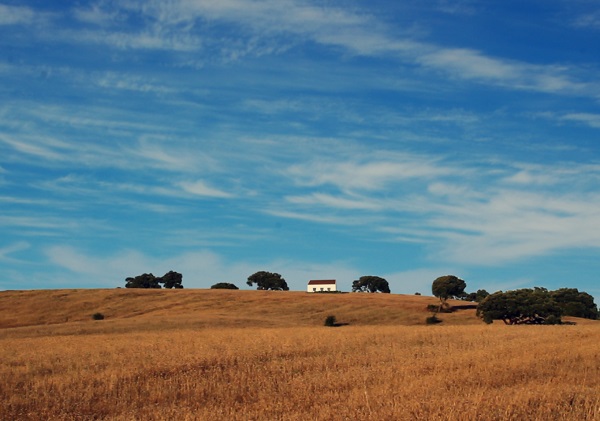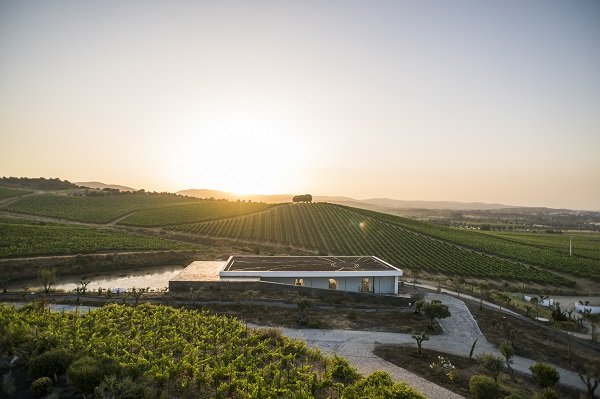The Alentejo, stretching from the banks of the Tejo River to the mountains that surround the Algarve, is the heartland of Portugal. This place has inspired countless epic tales and adventures featuring Moors, Romans, Phoenicians and Celts, each leaving their mark on the unique local culture. A land with intense flavors of wine and a local cuisine that is unlike anything else, and as fresh and as local as the land it comes from. A place where you can enjoy both bliss and thrills, surrounded by rolling plains and mountains, blue rivers, pristine beaches, and villages painted in white and blue. And, our sunlight is warm and unique. Discover the Portuguese region rich in natural beauty, adventure, culture, flavors and welcoming smiles. The name of the Alentejo comes from the Portuguese "Além” and "Tejo,” or beyond the River Tejo. And it is just 1 hour from Lisbon. Lots of sunshine and clear skies — almost 300 days of sunshine a year and precipitation only in the winter, allowing production year-round. Major airports are found in Lisbon, Faro, Seville and Beja.
The Alentejo is a sunny place of soft plains, occasional mountains, and vast cork forests. The Alentejo is a lightly populated region with open horizons, where the land produces more than half of the world's total cork supply.
From north to south, the region is surrounded by water with three main Portuguese rivers crossing the Alentejo and the Atlantic Ocean touching its southwestern coast. During the summer the green stands of cork oaks turn the flowing plains of the Alentejo into a golden and enchanting place of sun and shadows. Wine estates, olive groves, and a white and blue farmhouse on a hill occasionally interrupts these cork forests.

In the Alentejo, our history is everywhere. The Romans flourished here for centuries — building roads, vast farms, wineries and villas. Today, you can explore their legacy. In the Serra de São Mamede, see the lost Roman City of Ammaia, near Monforte at the Torre de Palma villa, you can see well-preserved mosaics of muses and horses. Évora boasts a rare standing Roman temple, as well as Roman walls. Further south, the amazingly preserved São Cucufate villa offers a rare glimpse of the lifestyle of Romans in the Alentejo.
Most small towns seem to float on hilltops above the plains, embraced by a castle. Gothic towers and red tiles rise from the venerable walls. From prehistory there are countless Dolmens, Menhirs, and burial mounds. Impressive Roman relics are everywhere, from the still-standing temple at Évora to a mostly intact Roman villa at São Cucufate. While the Alentejo flourished under centuries of Roman rule, it thrived in the 400 years that the Moors held it. They left behind cultural and architectural ties, a mosque at Mértola, and legends.
Portugal is a member of the Schengen Area, so most cast and crews can film for up to 90 days without a visa. Portugal has co-production agreements with more than 60 nations around the world. Applications for filming permits can be submitted through local towns, with a processing time of about one week. Processing times for filming on beaches are often less.
The Alentejo has beaches, castles, palaces, ruins, walled villages, churches, cathedrals, monasteries, mountains, historic and walled cities.
The Alentejo is framed to the North by the River Tejo, and by mountains to the South. Spain and the River Guadiana mark the border to the East, and the open Atlantic is the border to the West. The northeast of Cork Country is famed for its villages along the Castle Route: Nisa, Castelo de Vide, Marvão, Portalegre and Alter do Chão. Further south, the landscape becomes warmer and flatter. Around Évora (one of the most beautiful cities in Europe), one finds the enchanting walled towns of Monsaraz, Vila Viçosa, Estremoz, and Arraiolos (renowned for its handmade tapestries and rugs).
To the South, the rolling plains are even less inhabited, the only shade being provided by olive and cork oak trees. A trip to the museum-towns of Alvito, Beja, Serpa and Mértola will offer many memories.
To the West, the Alentejo’s coastline offers sandy Atlantic beaches, sea cliffs, and umbrella-like pine trees.
Here there are distinct seasons, with a green spring rich in wild flowers. In the early summer, storks build their nests on rooftops in whitewashed villages, and the heat turns the plains to gold. The winter is mild, but the open fields become bright yellow-green, and the shepherds dress in long capes to stay warm.
Alentejo is Portugal’s wine country where centuries of tradition and the latest technologies produce world-class wines. The region’s vineyards pre-date Roman rule, and today house more than 250 producers. The land is very productive due to the warm summer temperatures and abundance of sun, along with the wisdom of local winemakers. The resulting unique varieties range from light white wines to bold reds.
Portugal CASH REBATE https://portugalfilmcommission.com/en/made-in-portugal/
SCOUTING PROGRAM
Why the Global Film Sector Is Making the Pilgrimage to Portugal



